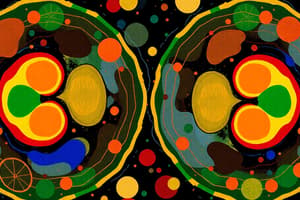Podcast
Questions and Answers
During which phase of the cell cycle does the cell primarily grow and perform its normal functions?
During which phase of the cell cycle does the cell primarily grow and perform its normal functions?
- Mitosis
- Prophase
- Interphase (correct)
- Metaphase
Which of the following is a key event that occurs during anaphase in mitosis?
Which of the following is a key event that occurs during anaphase in mitosis?
- Sister chromatids separate and move to opposite poles (correct)
- Nuclear envelope reforms around each set of chromosomes
- Chromosomes condense and become visible
- Chromosomes align at the metaphase plate
At what stage of mitosis does the nuclear envelope begin to break down?
At what stage of mitosis does the nuclear envelope begin to break down?
- Telophase
- Anaphase
- Prophase (correct)
- Metaphase
What is the correct order of the stages of mitosis?
What is the correct order of the stages of mitosis?
During telophase, what is the primary event?
During telophase, what is the primary event?
What is the phase of the cell cycle where DNA replication occurs?
What is the phase of the cell cycle where DNA replication occurs?
Which phase of mitosis is characterized by chromosomes aligning at the cell's equator?
Which phase of mitosis is characterized by chromosomes aligning at the cell's equator?
What structure organizes the spindle fibers during cell division in animal cells?
What structure organizes the spindle fibers during cell division in animal cells?
Which of the following is the longest phase of the cell cycle?
Which of the following is the longest phase of the cell cycle?
Which phase of mitosis involves the separation of sister chromatids?
Which phase of mitosis involves the separation of sister chromatids?
What is the outcome of mitosis in terms of chromosome number?
What is the outcome of mitosis in terms of chromosome number?
In which phase of mitosis does the nuclear envelope re-form around separated chromosomes?
In which phase of mitosis does the nuclear envelope re-form around separated chromosomes?
What term describes the physical division of the cytoplasm at the end of the cell cycle?
What term describes the physical division of the cytoplasm at the end of the cell cycle?
Which phase of meiosis involves crossing over of homologous chromosomes?
Which phase of meiosis involves crossing over of homologous chromosomes?
What is the key difference between mitosis and meiosis?
What is the key difference between mitosis and meiosis?
Flashcards
Mitosis
Mitosis
The process of cell division that produces two identical daughter cells, each with the same number of chromosomes as the parent cell.
Interphase
Interphase
The stage in the cell cycle where the cell grows, copies its DNA, and prepares for division. It is divided into three subphases: G1, S, and G2.
Prophase
Prophase
The first stage of mitosis, where the replicated chromosomes condense and become visible.
Metaphase
Metaphase
Signup and view all the flashcards
Anaphase
Anaphase
Signup and view all the flashcards
S phase (Synthesis phase)
S phase (Synthesis phase)
Signup and view all the flashcards
Metaphase
Metaphase
Signup and view all the flashcards
Centriole
Centriole
Signup and view all the flashcards
Anaphase
Anaphase
Signup and view all the flashcards
Interphase
Interphase
Signup and view all the flashcards
Diploid Cells
Diploid Cells
Signup and view all the flashcards
Telophase
Telophase
Signup and view all the flashcards
Cytokinesis
Cytokinesis
Signup and view all the flashcards
Prophase I
Prophase I
Signup and view all the flashcards
Mitosis vs. Meiosis
Mitosis vs. Meiosis
Signup and view all the flashcards
Study Notes
Cell Division
- Cell division is the process by which a cell divides into two or more daughter cells.
- Learning Outcomes: Students will be able to identify the stages of mitosis and meiosis, describe the stages of each process, and differentiate between mitosis and meiosis.
Cell Cycle
- Eukaryotic cell cycle is like prokaryotic cell cycle in that cells grow, DNA replicates, mitotic cell division produces daughter cells identical to the parent, and timing of replication and cell division is regulated.
- Two major phases: Interphase and Mitosis.
- Interphase consists of three stages: G₁, S, and G₂.
- Mitosis consists of four stages: Prophase, Metaphase, Anaphase, and Telophase followed by cytokinesis.
Interphase
- Non-dividing state with three sub-stages:
- Gap 1 (G₁): cell grows in size, organelles replicated, synthesis of DNA and proteins associated with DNA.
- Synthesis (S): DNA replication.
- Gap 2 (G₂): synthesis of proteins associated with mitosis.
Mitosis
- Division of somatic (non-reproductive) cells in eukaryotic organisms.
- A single cell divides into two identical daughter cells with the same number of chromosomes as the parent cell.
- Crucial for growth, repair, and asexual reproduction.
Packing for the Move...
- When a cell isn't dividing, DNA is in an extended, uncondensed form called chromatin.
- DNA replication and transcription occur in this state.
- When preparing for division, DNA condenses into chromosomes.
- This makes it easier to sort and organize replicated DNA into daughter cells.
Mitosis Sub-phases
- Prophase: Chromosomes condense, spindle fibers form, and chromosomes are captured by the spindle. The nuclear envelope breaks down.
- Metaphase: Chromosomes align along the equator of the cell with one kinetochore facing each pole.
- Anaphase: Sister chromatids separate, spindle fibers shorten pulling chromatids toward the poles, and free spindle fibers lengthen pushing the poles apart.
- Telophase: Spindle fibers disintegrate, nuclear envelopes form around both groups of chromosomes, chromosomes revert to their extended state, and cytokinesis occurs, enclosing each daughter nucleus into a separate cell.
Cytokinesis - Plant vs. Animal Cell
- Plant cells: Cytokinesis occurs by forming a cell plate between the two daughter nuclei.
- Animal cells: Cytokinesis occurs through the formation of a cleavage furrow—a ring of microtubules contract, pinching the cell in half.
Germ Cells vs. Somatic Cells
- Germ cells are reproductive cells (like sperm and egg cells)
- Somatic cells are all other body cells
Meiosis
- Cell division of gametes (germ cells).
- A single germ cell divides into four unique daughter cells.
- Daughter cells have half the number of chromosomes as the parent cell, making them haploid.
Genetics Terminology: Ploidy
- Haploid (n): one copy of each chromosome
- Diploid (2n): two sets of chromosomes
Genetics Terminology: Homologues
- Chromosomes exist in homologous pairs in diploid cells.
- Homologues are chromosomes that contain the same genes in the same order.
- Sex chromosomes (X and Y) are an exception, not a homologous pair.
Meiosis I
- Prophase I: Chromosomes condense, nuclear envelope breaks down, crossing over occurs.
- Metaphase I: Homologous chromosomes align along the equator.
- Anaphase I: Homologous chromosomes move to opposite poles.
- Telophase I & cytokinesis: Chromosomes gather at poles, cytoplasm divides.
Crossing Over
- Homologous chromosomes break at identical locations and rejoin opposite partners.
- Creates new combinations of alleles on each chromosome.
- Occurs randomly several times on every chromosome.
- Gene mixing from parents.
Meiosis II
- Prophase II: A new spindle forms around the chromosomes.
- Metaphase II: Metaphase II chromosomes line up at the equator.
- Anaphase II: Centromeres divide, chromatids move to opposite poles.
- Telophase II & cytokinesis: Nuclear envelope forms, cytoplasm divides, resulting in four haploid daughter cells.
Mitosis and Meiosis Venn Diagram
- Similarities: Both involve DNA replication, same basic steps, occur in plants and animals, and start with diploid parent cells.
- Differences: Mitosis produces two diploid cells genetically identical, while Meiosis produces four haploid cells genetically different. Mitosis is for cell growth and repair, Meiosis for the creation of germ cells.
Studying That Suits You
Use AI to generate personalized quizzes and flashcards to suit your learning preferences.





